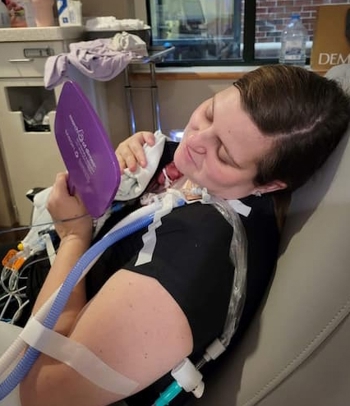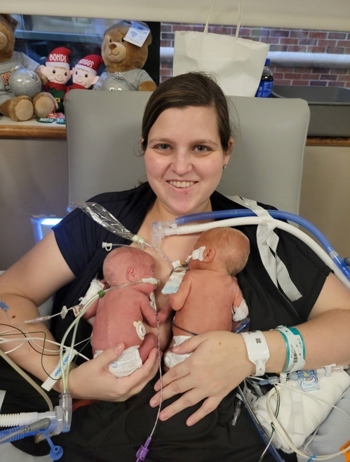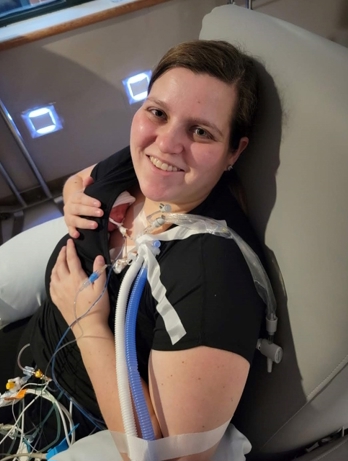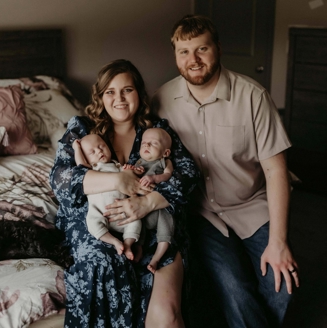Skin-to-skin ‘kangaroo care’ improves lives of premature babies (and their parents)

Cords and wires. Feeding tubes, IVs, a PICC line. A room full of nurses, a respiratory therapist, extra pillows. Brianna Schmitz was surrounded when she first got to hold one of her premature twin sons, yet felt terrified as he was transferred into her arms.
“The slowest, scariest walk of my life,” she said. “I still look back, and I'm like, ‘Holy cow, did we actually do that?’”
Bodhi was just days old and not even two pounds when he and his brother were born at just 28 weeks, but the Neonatal Intensive Care Unit (NICU) team members prioritized the close contact. One of the nurses there, Kayla Hewitt, RN, BSN, RNC-NIC, NICU Charge Nurse, was “phenomenal,” Schmitz said, as she remembered how much she helped her as a new mom.
“I will sing her praises forever,” Schmitz said. “As soon as I walked in, she was like, ‘Hi, I’m Kayla.’ And then she said, ‘So, my goal is for you to hold Bodhi today if you want.’ And I just sobbed because I didn’t think that would be a possibility.”
Yet, that’s precisely why it was so important, given Bodhi’s small size. The exercise was part of the hospital’s Kangaroo Care program.
“Our babies are born so early, and it used to be we hardly got these babies out to be held,” said Dianne Wilderson, RN, MSN, RNC-NIC, nursing program coordinator for the Intensive Care Nursery. “But now we’re finding that if we can get them out and have them do kangaroo care with their families, it just has so many benefits.”
History and benefits of kangaroo care

The Kangaroo Care Program at Children’s Mercy Kansas City is based on Kangaroo Mother Care, a groundbreaking program first developed in 1978 in Colombia, when a physician was struggling with a shortage of incubators and a high number of premature births. By mimicking the way kangaroo mothers carry and protect their joeys, he developed a similar method for humans, where the new infant, wearing only a diaper, is placed directly on a parent’s bare chest.
The warmth of the parent’s skin, the close proximity to the heartbeat, and the physical closeness all lead to some incredible physiological benefits: a more regular heart rate and breathing, improved weight gain, reduced pain, improved sleep, better head circumference growth and improved oxygen saturation, as well as less crying, easier breastfeeding and shorter hospital stays. The World Health Organization estimates the practice can potentially save the lives of as many as 450,000 babies every year.
Even after leaving the hospital, babies experience many long-term benefits as well, including a higher degree of attachment and bonding to their mothers over time. And one 20-year follow-up study found that parents who participated in kangaroo care were “more protective and nurturing,” while their grown children exhibited better attendance and participation at school and fewer behavioral issues as they grew up.
In fact, the effects could be seen in brain neuroimaging of the kangaroo care children, who had a larger volume of the left caudate nucleus, a brain structure involved with learning, language and memories.
Schmitz said she saw immediate benefits from the kangaroo care, first with Bodhi and later with his twin brother, Briggs (and eventually both boys together).
“I have no doubt it helped with my milk supply,” she said. “I always produced more after I held them. And then just being able to hold them is obviously a very big bonding experience.”
Hewitt agreed and said the practice is crucial to establishing that initial parent-child connection.
“It's hard to bond with a critically ill infant when you feel like you can't pick them up to hold, feed or comfort them,” she said.
Reaching more parents

For the team at Children’s Mercy, the program requires ongoing education of new parents, many of whom are unfamiliar with the power of kangaroo care and also likely apprehensive to hold their babies in such a fragile state.
“Sometimes when the babies are so sick, families are scared to even touch their babies,” said Wilderson. “So, if we can get them where they feel a purpose to be at the bedside, it’s a win-win for everybody.”
Parents are educated through printed literature and educational videos, and new hires at the hospital are trained how to safely implement the program. While some infants are ineligible for kangaroo care if their providers deem them unstable, the team tries to accommodate most babies — and is constantly seeking to increase not only the number of babies who receive kangaroo care but also the amount of time spent with skin-to-skin contact. In the past year, the team surpassed their initial goal of a 10% increase in minutes and achieved a total of 26,452 minutes of kangaroo care, an increase of 36% over the previous year.
Hewitt said that prioritizing the program with parents remain so important.
“We do everything possible to eliminate/avoid the risks because the reward is so worth it,” she said. “I believe that if the nurse and medical team prioritizes and appreciates the importance of kangaroo care, the family will, too.”
And kangaroo care is not just limited to mothers; research has shown that fathers also give and receive the same benefits.
“It’s something they can do for their baby that is so beneficial,” Wilderson said. “Kangaroo care finally makes them feel like a parent. … I’m very fortunate to work with some very passionate staff who definitely see the value of taking the extra time to make sure our families get to do kangaroo care!”
Kangaroo care at home

Bodhi ended up spending 125 days at Children’s Mercy, Briggs a total of 141 days. Yet, from the very beginning, both mom and dad were there, holding them as much as they could while their sons slowly grew stronger. It all began with that first session that lasted nearly three hours.
“The respiratory therapist gave me a little mirror so I could see his face when he was on my chest,” Schmitz said. “That was probably like the best day of my life, just knowing it was even a possibility. It was exactly what I needed, and I think I held him every day since.”
Now at home, kangaroo care is “still our favorite part of every day,” Schmitz said, and both boys were able to come home without oxygen and taking all feedings by mouth. She recommends kangaroo care for every new parent.
“It's scary, and it's a lot at the beginning, especially if they're intubated. But trust your nurses. They know what they're doing, they know how to do it safely, and there are so, so many benefits.”
